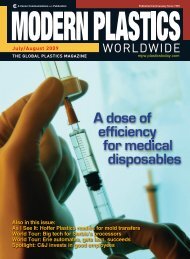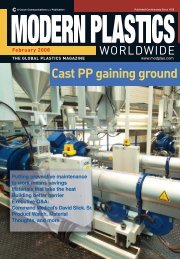amidiq - dae uptlax
amidiq - dae uptlax
amidiq - dae uptlax
You also want an ePaper? Increase the reach of your titles
YUMPU automatically turns print PDFs into web optimized ePapers that Google loves.
298<br />
J. Romero-González et al. / Revista Mexicana de Ingeniería Química Vol. 6, No. 3 (2007) 295-300<br />
amount of solute adsorbed at any time (mg/g), and<br />
K ’ ad is the rate constant of first-order biosorption<br />
(min -1 ). If equation (1) is integrated for the boundary<br />
conditions t=0 to t >0 and q=0 to q>0, the following<br />
linear time dependence function is obtained:<br />
log( q − q) = log( q ) − ( K´ /2.302) t (2)<br />
e e ad<br />
Table 2. Time profile for Pb(II) biosorption by<br />
Agave azul biomass.<br />
Time Metal in Metal onto<br />
[min] liquid biomass<br />
5 23% 77%<br />
10 21% 79%<br />
15 19% 81%<br />
30 10% 90%<br />
45 10% 90%<br />
60 10% 90%<br />
90 10% 90%<br />
120 9% 91%<br />
The experimental data obtained from time<br />
dependence study was used in equation (2). The<br />
results of the appropriate calculations are shown in<br />
Fig. 1. The data shown in this figure were used to<br />
estimate the constants shown in Table 3.<br />
log(qe-q) mg/g<br />
0<br />
0 20 40 60 80 100 120 140<br />
-0.5<br />
-1<br />
-1.5<br />
-2<br />
-2.5<br />
Time (min)<br />
y = -0.0125x - 0.424<br />
R 2 = 0.9453<br />
Fig. 1. Linear plot of first order for the adsorption of<br />
Pb(II) to Agave tequila Weber biomass.<br />
Table 3. Comparative analysis of linear pseudo first<br />
order and pseudo second order rate equations, their<br />
constants and correlation coefficients (R 2 values), for<br />
the adsorption of Pb(II) to Agave tequilana Weber<br />
biomass.<br />
Model type Constant of<br />
Pseudo first<br />
order<br />
Pseudo<br />
second order<br />
pseudo reaction<br />
K’ad = 0.035 min -<br />
1<br />
K”ad = 0.572<br />
(g mg -1 min -1 ).<br />
qe<br />
R 2<br />
(mg/g)<br />
0.53 0.9453<br />
0.45 0.9895<br />
The pseudo-second order model (Ho and<br />
McKay, 1999) is also based on the sorption capacity<br />
of the solid phase. The pseudo second-order<br />
chemisorption kinetic rate equation is expressed as<br />
the following:<br />
2<br />
dq / dt = K´´ ad ( qe − q)<br />
(3)<br />
where K ” ad is the rate constant of second-order<br />
biosorption (g·mg -1 ·min -1 ), q and qe represent the<br />
variables explained before. Integrating Eq. (3) for the<br />
boundary conditions t=0 to t>0 and q=0 to q>0, the<br />
following linear time dependence function is<br />
obtained:<br />
2<br />
t/ q = 1/2 K´´ ad qe+ (1/ qe) t (4)<br />
The experimental data obtained from time<br />
dependence study was used in Eq. (4). The results of<br />
the appropriate calculations are shown in Fig. 2. The<br />
data shown in this figure were used to estimate the<br />
constants shown in Table 3.<br />
t/q (min g/mg)<br />
300<br />
250<br />
200<br />
150<br />
100<br />
50<br />
y = 1.8163x + 23.334<br />
R 2 = 0.9895<br />
0<br />
0 20 40 60 80 100 120 140<br />
Time (min)<br />
Fig. 2. Linear plot of pseudo second order for the<br />
adsorption of Pb(II) to Agave tequilana Weber<br />
biomass.<br />
The comparative analysis of R 2 values shown<br />
in Table 3 indicates that a pseudo-second order (R 2 ><br />
0.9895) reaction model explain better the kinetic data<br />
for Pb(II) sorption to Agave azul biomass. These<br />
results suggest that a rate-limiting step may be the<br />
chemical adsorption process of Pb(II) binding to<br />
Agave azul biomass. This process involves an<br />
exchange of electrons between the adsorbate and the<br />
surface of the adsorbing material. Similar results<br />
were reported by Ho and McKay (1999) for Pb(II)<br />
adsorption by cypress leaves and peat.<br />
3.3 Sorption Isotherms<br />
The Langmuir and Freundlich isotherms are<br />
the most widely used models for studying the<br />
sorption equilibrium between the metal solution and<br />
the solid biomass phase (Davis et al., 2003, Goyal et<br />
al., 2003, Martínez et al., 2000, Martínez et al.,<br />
1998, Krishna et al., 2000, Benhammou et al., 2005,<br />
Volesky, 2003). The Langmuir isotherm is a nonlinear<br />
model that is based on a first order equilibrium<br />
kinetics. In this model the biosorbed metal covers a<br />
monolayer on the homogeneous solid surface, where<br />
all the superficial binding sites have uniform<br />
adsorption energies without any interaction between<br />
the adsorbed molecules (Goyal et al., 2003, Romero-<br />
Gonzalez et al., 2005a). This model is represented in<br />
Eq. (1).<br />
QbC L e<br />
qe<br />
=<br />
(5)<br />
1+<br />
bC<br />
( )<br />
where qe is the quantity of metal adsorbed at<br />
equilibrium over the mass of adsorbent biomass (mol<br />
g -1 ); QL stands for the monolayer adsorption<br />
capacity, defined as the maximum amount of metal<br />
e









